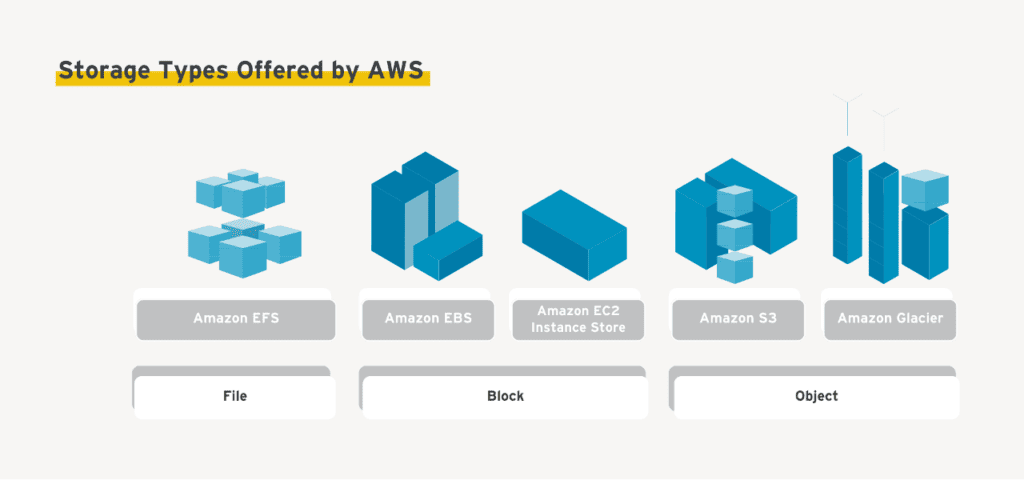Amazon Simple Storage Service (S3) is a powerful, scalable and secure cloud storage service from Amazon Web Services (AWS). This makes this service one of the most important components of AWS. S3 offers a reliable way to store, organize and restore data. In addition to the storage of data from IT, S3 is increasingly being used for the storage of data from OT (e.g. machines and sensor data). The following article introduces the differences, advantages and interfaces of AWS S3 for the integration of machine data.
What is AWS S3 and how does it differ from other AWS storage types?
Amazon Web Services (AWS) offers a wide range of storage types to meet the different requirements of users.

- Amazon S3 (Simple Storage Service): S3 is a scalable and highly available object storage service, perfect for storing and retrieving objects of any kind. Objects can be files, images, videos or other types of data. This makes S3 particularly suitable for backups, archiving and as data storage for applications.
- Amazon EFS (Elastic File System): EFS provides a scalable and fully managed file storage for AWS workloads. This makes EFS ideal for applications that require shared file storage between multiple instances.
- Amazon EBS (Elastic Block Store): EBS provides persistent block storage that can be attached to individual EC2 instances. Suitable for databases, boot volumes and applications that require high-performance, single storage.
- Amazon Glacier: Glacier is a cost-effective storage solution for archive data and long-term backups. Designed for the economical long-term archiving of rarely used data.
- EC2 Instance Storage: Each Amazon EC2 instance has temporary instance storage that is directly connected to the instance. This provides fast, temporary storage space, but this is lost when the instance is terminated.
The advantages of S3 in an industrial context
AWS S3 offers numerous advantages for the integration and storage of machine data, including:
- Scalability: S3 is highly scalable and can easily meet the growing requirements of factories and production environments.
- Security: The service has comprehensive security features, including access controls and encryption of data at rest and in transit.
- High availability: S3 offers high availability of your data, which is particularly important if you rely on uninterrupted data usage.
- Easy integration: The service is seamlessly integrated with other AWS services, which greatly simplifies application development and data processing.
- Versioning: S3 supports the versioning of objects. This means that older versions can be restored if an object is changed or deleted.
AWS S3 for storing machine data – use-cases
The cloud service is used in a variety of ways in the factory environment, for example:
- Data backup and archiving: You can securely store factory data, logs and recordings in Amazon S3. The service is very well suited for long-term data storage.
- Data distribution and sharing: Amazon S3 enables the secure distribution of data to external supply chain partners or internal departments.
- Processing and analysis of production data: Data generated in production facilities can be stored in Amazon S3 and made available for analysis in other AWS services.
Interfaces for the integration of machine data
Various interfaces and services are available for the integration of external devices (such as IoT devices, sensors, industrial control systems) with AWS S3 and the broader AWS ecosystem. Here is an overview of the most important interfaces and methods:
- AWS IoT Core: For connecting IoT devices to the cloud to securely collect and transfer data.
- AWS SDKs and AWS Amplify: Simplify the development of applications that communicate with AWS services with support for multiple programming languages and platforms.
- AWS Greengrass: Enables local data processing on devices with subsequent transfer to the cloud.
- RESTful API: For direct interaction with AWS S3 via HTTP requests. It allows developers to use standard HTTP methods such as GET, PUT, DELETE and POST to create, retrieve, update or delete objects in S3 buckets. This includes uploading files, retrieving file lists in a bucket, deleting files and managing access permissions. The RESTful API of S3 is particularly interesting for direct integration with the S3 service without having to resort to higher abstracted libraries or SDKs.
i-flow and Amazon S3 – A synergy in data processing
i-flow and Amazon S3 combine to provide a comprehensive solution for integrating data as well as secure transmission and storage in the cloud. i-flow serves as a link between production systems and the cloud environment. Data is harmonized in i-flow, processed and made available in the cloud. i-flow enables the orchestration of data flows and automation functions to optimize data processing and analysis in edge and cloud environments.

